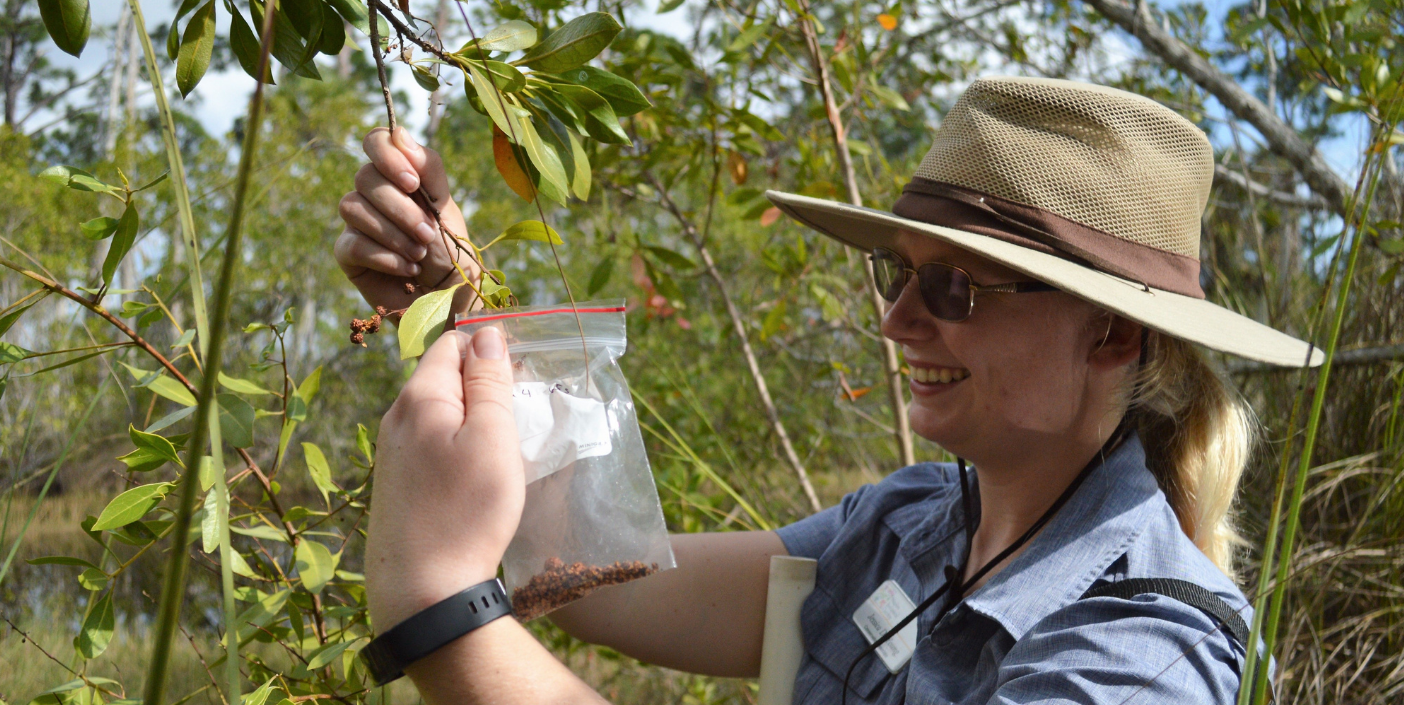
If there is such a thing as a pandemic-perfect job, Jessica DeYoung’s may be it. The conservation associate, under the supervision of Vice President of Conservation Chad Washburn, spends her days in the field or in plant nurseries, conducting extensive research into the plants found in our natural areas and in portions of Rookery Bay, where we partner with Rookery Bay National Estuarine Research Reserve scientists. Some, like the pigeonplum tree (Coccoloba diversifolia), have tremendous potential as a landscape plant—if better understood. Others, such as the giant airplant (Tillandsia utriculata), are disappearing in the wild. All of them—even the abundant ones—face threats such as habitat loss, climate-related stress, and disease.
DeYoung’s research, which eventually will be shared publicly, will arm conservationists, nursery managers, plant enthusiasts, and others with the knowledge of how to grow and preserve these plants, helping ensure their long-term survival.

“It’s not just about rare species,” Washburn notes. “Everything is under threat right now.”
While that may imply we need answers fast, the act of discovery is methodical, multi-pronged, and years in the making.
“The in-depth research is what we’re really missing,” DeYoung says. Here’s a glimpse into seven steps the Garden team takes to understand and conserve the region’s plants.
 1. Find the plant
1. Find the plant
For about a year, DeYoung combed our natural areas to discover the plants we have growing on site and target those she wished to study. She focused on the scrub habitat, high and dry land that developers favor. DeYoung and Washburn want to ensure the Garden conserves plants of the scrub before they’re lost to housing developments and commercial centers.
 2. Observe the targeted species
2. Observe the targeted species
Before she could even start conducting seed research, DeYoung had to learn more about plants, their habitats, when they flower, when their seed is ready to collect, how much seed she can expect to harvest from various plants (conservation norms dictate taking 20% or less of a plant’s seed). Watching the plants in nature would inform the experiments she would conduct and determine the growing conditions the plants would need in the nursery.

3. Conduct propagation experiments
This is the heart of DeYoung’s work. She aims to figure out what compels a seed to germinate. Some sprout more readily after a period in storage, likely because they’re genetically programmed to stay dormant during Florida’s dry season and activate during the wet. Some wetland seeds germinate best after soaking. Other types need their tough seed coats to erode before they can sprout, a process that occurs as wind scrapes them against surfaces, water washes them over rock, or animals eat and expel them. DeYoung must figure out what natural process, if any, she must replicate to achieve germination. Then, she drills into specifics: Store the seed for how long? At what temperature? In a moist environment or a dry one? For how long must they soak? What’s the best way to mimic digestion? These are just a sampling of the many questions DeYoung investigates.

4. Analyze the findings
Some of DeYoung’s findings beg for more experimentation. Why, for example, did she observe nearly identical germination rates for pineland purple (Carphephorus odoratissimus var. subtropicanus) seeds that were stored at room temperature as those stored at moist, cold temperatures for the same period of time? Could she potentially double the lignum vitae’s (Guaiacum sanctum) germination rate if she combined two seed treatments each about 40 percent effective on their own? When it comes to botanical research, one round of data is rarely enough.

5. Monitor growth
DeYoung’s work doesn’t end when seeds sprout. She regularly visits our nurseries to monitor how they fare in various growing media, light intensities, watering frequencies, and the like. The information she gleans will be documented and shared, along with the results of the propagation experiments in Step 3.
 6. Maintain the seed bank
6. Maintain the seed bank
The Garden last year started a seed bank to conserve plants such as the natives that DeYoung collects. Seed storage opens another line of investigation. DeYoung removes seeds from the freezer at three-month intervals to see how well they germinate. Because she’s already figured out the protocols for growing the seeds, she can focus on a narrow question—for how long do the preserved seeds remain viable?
7. Publish the data
Ultimately, DeYoung will produce detailed “propagation protocols” describing how to successfully produce plants from seed. Her instructions will include everything from her research-based propagation methods to creating ideal growing conditions to storing seeds for the long term. DeYoung is working with 55 species, all of which are in different stages of research and discovery. She’s not ready to share her findings publicly yet, but when she does, researchers and plant enthusiasts will be able to “Google” native species and find answers—thanks to the ongoing research at the Garden.
This article originally appeared in the Fall 2020 issue of Cultivate, the Garden’s magazine. Editor’s Note: DeYoung has since been promoted to Conservation Horticulture Manager.
 About the Author
About the Author
Jennifer Reed is the Editorial Director of Naples Botanical Garden and a longtime Southwest Florida journalist.


